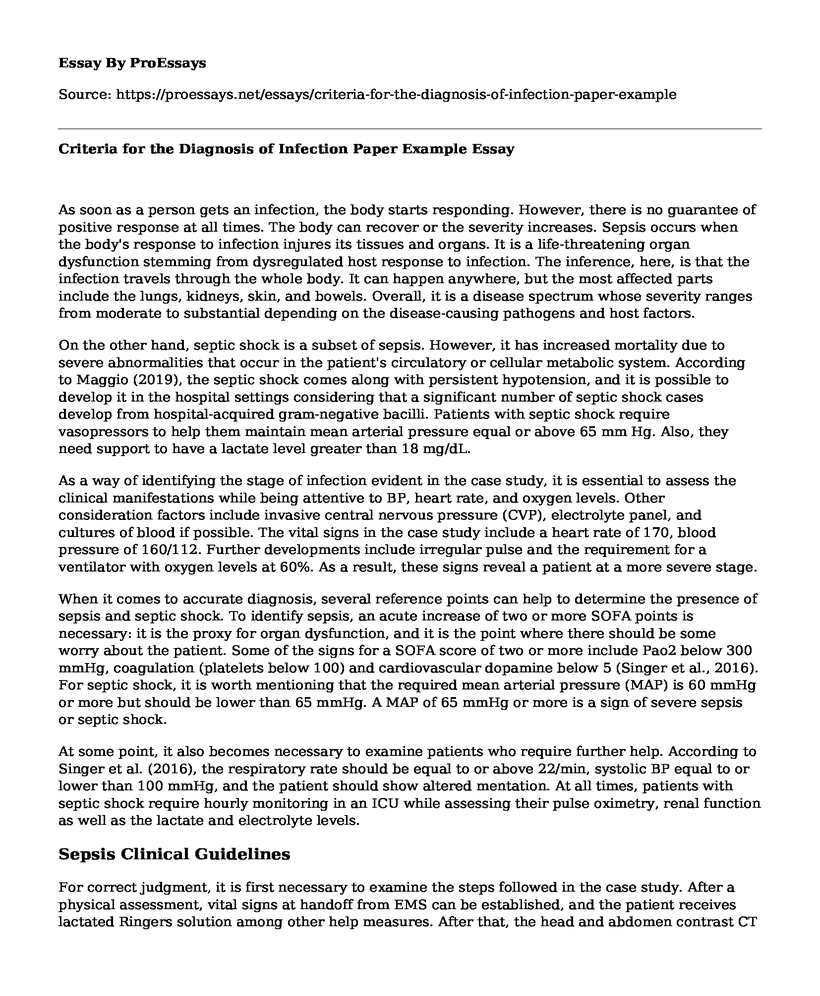As soon as a person gets an infection, the body starts responding. However, there is no guarantee of positive response at all times. The body can recover or the severity increases. Sepsis occurs when the body's response to infection injures its tissues and organs. It is a life-threatening organ dysfunction stemming from dysregulated host response to infection. The inference, here, is that the infection travels through the whole body. It can happen anywhere, but the most affected parts include the lungs, kidneys, skin, and bowels. Overall, it is a disease spectrum whose severity ranges from moderate to substantial depending on the disease-causing pathogens and host factors.
On the other hand, septic shock is a subset of sepsis. However, it has increased mortality due to severe abnormalities that occur in the patient's circulatory or cellular metabolic system. According to Maggio (2019), the septic shock comes along with persistent hypotension, and it is possible to develop it in the hospital settings considering that a significant number of septic shock cases develop from hospital-acquired gram-negative bacilli. Patients with septic shock require vasopressors to help them maintain mean arterial pressure equal or above 65 mm Hg. Also, they need support to have a lactate level greater than 18 mg/dL.
As a way of identifying the stage of infection evident in the case study, it is essential to assess the clinical manifestations while being attentive to BP, heart rate, and oxygen levels. Other consideration factors include invasive central nervous pressure (CVP), electrolyte panel, and cultures of blood if possible. The vital signs in the case study include a heart rate of 170, blood pressure of 160/112. Further developments include irregular pulse and the requirement for a ventilator with oxygen levels at 60%. As a result, these signs reveal a patient at a more severe stage.
When it comes to accurate diagnosis, several reference points can help to determine the presence of sepsis and septic shock. To identify sepsis, an acute increase of two or more SOFA points is necessary: it is the proxy for organ dysfunction, and it is the point where there should be some worry about the patient. Some of the signs for a SOFA score of two or more include Pao2 below 300 mmHg, coagulation (platelets below 100) and cardiovascular dopamine below 5 (Singer et al., 2016). For septic shock, it is worth mentioning that the required mean arterial pressure (MAP) is 60 mmHg or more but should be lower than 65 mmHg. A MAP of 65 mmHg or more is a sign of severe sepsis or septic shock.
At some point, it also becomes necessary to examine patients who require further help. According to Singer et al. (2016), the respiratory rate should be equal to or above 22/min, systolic BP equal to or lower than 100 mmHg, and the patient should show altered mentation. At all times, patients with septic shock require hourly monitoring in an ICU while assessing their pulse oximetry, renal function as well as the lactate and electrolyte levels.
Sepsis Clinical Guidelines
For correct judgment, it is first necessary to examine the steps followed in the case study. After a physical assessment, vital signs at handoff from EMS can be established, and the patient receives lactated Ringers solution among other help measures. After that, the head and abdomen contrast CT scan takes place. More physical assessment before admission to the surgical intensive care unit is evident too. Shortly, he receives the first dose of intravenous. Elective intubation follows, and the patient is placed on a ventilator.
References
Maggio, P. M. (2019). Sepsis and Septic Shock. Merck Manual. Retrieved from https://www.merckmanuals.com/professional/critical-care-medicine/sepsis-and-septic-shock/sepsis-and-septic-shock
Singer, M., Deutschman, C. S., Seymour, C. W., Shankar-Hari, M., Annane, D., Bauer, M., ... & Hotchkiss, R. S. (2016). The third international consensus definitions for sepsis and septic shock (Sepsis-3). Jama, 315(8), 801-810. doi:10.1001/jama.2016.0287
Cite this page
Criteria for the Diagnosis of Infection Paper Example. (2022, Dec 12). Retrieved from https://proessays.net/essays/criteria-for-the-diagnosis-of-infection-paper-example
If you are the original author of this essay and no longer wish to have it published on the ProEssays website, please click below to request its removal:
- Alcoholic Liver Disease Paper Example
- Affordable Care Act and Patient Advocacy Essay Example
- Essay Example on Modern Technology Enhancing Nursing Practice
- Research Paper on Social Work: Preventing Social Exclusion & Inclusion for Deviant Behaviors
- Paper Example on Food Deserts: Causes of Nutritional Inequality
- Essay Sample:The Great Recession's Impact on People with Disabilities
- Paper Example on Analysis of Prehospital Rapid Sequence Intubation in Emergency Service South Africa







